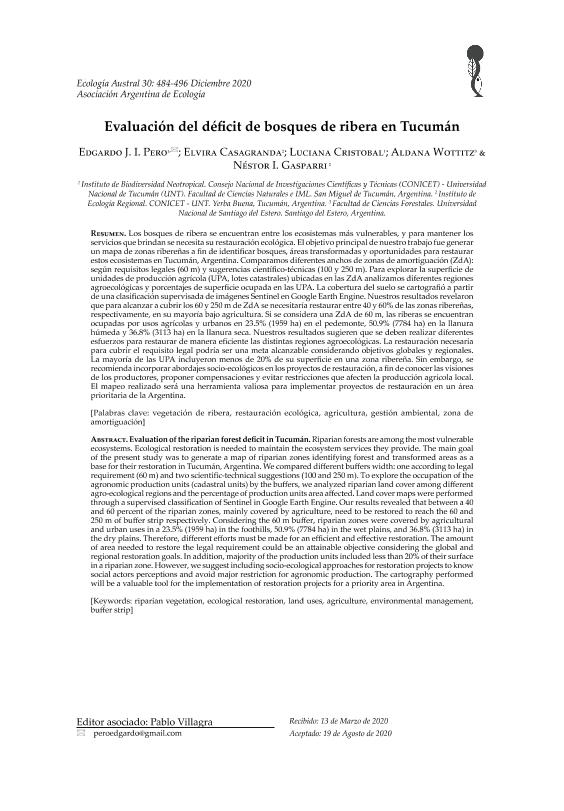Artículo
Los bosques de ribera se encuentran entre los ecosistemas más vulnerables. La restauración ecológica es necesaria para mantener los servicios que brindan. El objetivo principal del presente estudio fue generar un mapa de zonas ribereñas para identificar bosques, áreas transformadas y oportunidades para la restauración de estos ecosistemas en Tucumán, Argentina. Comparamos diferentes anchos de zonas de amortiguación (ZdA): según requisitos legales (60 m) y sugerencias científico-técnicas (100 y 250 m). Para explorar la superficie de unidades de producción agrícola (UPA, lotes catastrales) ubicadas en las ZdA, analizamos diferentes regiones agroecológicas y porcentajes de superficie ocupada en las UPA. La cobertura del suelo se cartografió a partir de una clasificación supervisada de imágenes Sentinel en Google Earth Engine. Nuestros resultados revelaron que entre un 40 y un 60 % de las zonas ribereñas, principalmente ocupadas por agricultura, necesitarían ser restauradas para alcanzar a cubrir los 60 y 250 m de ZdA, respectivamente. Considerando la ZdA de 60 m, las riberas se encuentran ocupadas por usos agrícolas y urbanos en un 23.5 % (1959 ha) en el pedemonte, 50.9 % (7784 ha) en la llanura húmeda, y 36.8 % (3113 ha) en la llanura seca. Los resultados sugieren que se deben realizar diferentes esfuerzos para una restauración eficiente en las distintas regiones agroecológicas. La restauración necesaria para cubrir el requisito legal podría ser una meta alcanzable considerando objetivos globales y regionales. La mayoría de las UPA incluyeron menos del 20 % de su superficie en una zona ribereña. Sin embargo, se recomienda incluir abordajes socio-ecológicos en los proyectos de restauración a fin de conocer las visiones de los productores, proponer compensaciones y evitar restricciones importantes para la producción agrícola local. El mapeo realizado será una herramienta valiosa para la implementación de proyectos de restauración para un área prioritaria en Argentina. Riparian forests are among the most vulnerable ecosystems. Ecological restoration is needed to maintain the ecosystem services they provide. The main goal of the present study was to generate a map of riparian zones identifying forest and transformed areas as a base for their restoration in Tucumán, Argentina. We compared different buffers width: one according to legal requirement (60 m) and two scientific-technical suggestions (100 and 250 m). To explore the occupation of the agronomic production units (cadastral units) by the buffers, we analyzed riparian land cover among different agro-ecological regions and the percentage of production units area affected. Land cover maps were performed through a supervised classification of Sentinel in Google Earth Engine. Our results revealed that between a 40 and 60 percent of the riparian zones, mainly covered by agriculture, need to be restored to reach the 60 and 250 m of buffer strip respectively. Considering the 60 m buffer, riparian zones were covered by agricultural and urban uses in a 23.5% (1959 ha) in the foothills, 50.9% (7784 ha) in the wet plains, and 36.8% (3113 ha) in the dry plains. Therefore, different efforts must be made for an efficient and effective restoration. The amount of area needed to restore the legal requirement could be an attainable objective considering the global and regional restoration goals. In addition, majority of the production units included less than 20% of their surface in a riparian zone. However, we suggest including socio-ecological approaches for restoration projects to know social actors perceptions and avoid major restriction for agronomic production. The cartography performed will be a valuable tool for the implementation of restoration projects for a priority area in Argentina.
Evaluación del déficit de bosques de ribera en Tucumán
Título:
Evaluation of the riparian forest deficit in Tucumán
Pero, Edgardo Javier Ignacio ; Casagranda, Maria Elvira
; Casagranda, Maria Elvira ; Cristobal, Luciana María
; Cristobal, Luciana María ; Wottitz, Aldana; Gasparri, Nestor Ignacio
; Wottitz, Aldana; Gasparri, Nestor Ignacio
 ; Casagranda, Maria Elvira
; Casagranda, Maria Elvira ; Cristobal, Luciana María
; Cristobal, Luciana María ; Wottitz, Aldana; Gasparri, Nestor Ignacio
; Wottitz, Aldana; Gasparri, Nestor Ignacio
Fecha de publicación:
12/2020
Editorial:
Asociación Argentina de Ecología
Revista:
Ecología Austral
ISSN:
0327-5477
Idioma:
Español
Tipo de recurso:
Artículo publicado
Clasificación temática:
Resumen
Palabras clave:
RIBERA
,
RESTAURACIÓN ECOLÓGICA
,
AGRICULTURA
,
ZONA DE AMORTIGUACIÓN
Archivos asociados
Licencia
Identificadores
Colecciones
Articulos(IBN)
Articulos de INSTITUTO DE BIODIVERSIDAD NEOTROPICAL
Articulos de INSTITUTO DE BIODIVERSIDAD NEOTROPICAL
Articulos(IER)
Articulos de INSTITUTO DE ECOLOGIA REGIONAL
Articulos de INSTITUTO DE ECOLOGIA REGIONAL
Citación
Pero, Edgardo Javier Ignacio; Casagranda, Maria Elvira; Cristobal, Luciana María; Wottitz, Aldana; Gasparri, Nestor Ignacio; Evaluación del déficit de bosques de ribera en Tucumán; Asociación Argentina de Ecología; Ecología Austral; 30; 3; 12-2020; 484-496
Compartir
Altmétricas



